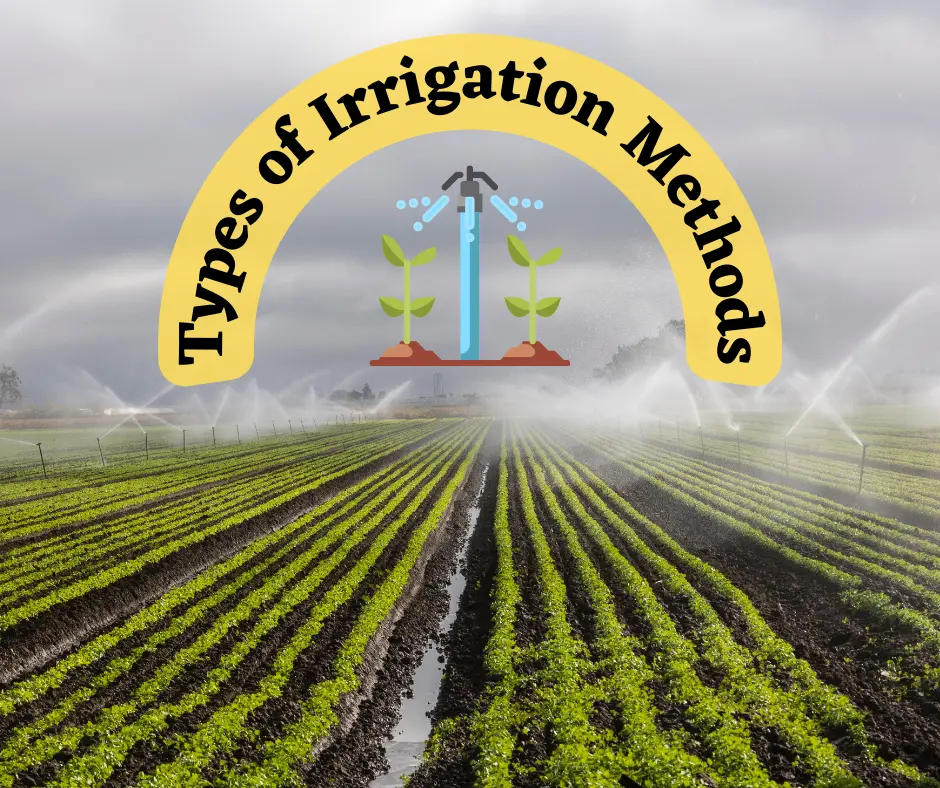Introduction:
Types of Irrigation Methods: Agriculture forms the backbone of Pakistan’s economy, feeding millions and providing employment to a significant portion of the population. As we look toward the future, the role of modern irrigation methods becomes increasingly critical. Efficient irrigation systems can dramatically enhance crop yields, conserve water, and contribute to sustainable farming practices. In this article, we explore different irrigation methods, their importance, benefits, and how they can be effectively managed to support agriculture in Pakistan.
Importance of Better Irrigation Methods
Types of Irrigation Methods: Irrigation is essential for healthy crop growth, especially in regions like Pakistan, where rainfall is unpredictable and often insufficient. Relying solely on rainwater is impractical for most farmers, making efficient irrigation methods crucial. The right irrigation system can prevent overwatering, which is equally harmful as drought conditions, and ensure that crops receive the optimal amount of water for growth. Better irrigation practices can help minimize soil erosion, conserve water, and improve overall crop productivity, thus supporting the agricultural sector’s sustainability and profitability.
Crop Rotation and Soil Management: Boosting Yields for a Sustainable Future
Types of Irrigation Methods
- Drip Irrigation Systems: Drip irrigation involves a network of tubes with small holes or emitters, either placed above or below the soil surface, that slowly drip water directly to the plant roots. This method is widely used in orchards, vineyards, and for high-value vegetable crops.
Advantages:
- Uses 30-50% less water than traditional methods.
- Prevents soil erosion and nutrient runoff.
- It allows deep soil penetration and reduces fungal growth.
- Easy to modify and control.
Sprinkler Irrigation:
- Sprinkler irrigation systems spread water through a series of pipes, spraying it over specific areas. Micro sprinklers are particularly effective for tree crops.
Advantages:
- Affordable and easy to set up.
- Provides even water distribution.
- Suitable for large areas.
- Allows for controlled watering to minimize evaporation.
Centre Pivot Irrigation:
- Centre pivot systems are self-propelled, rotating around a central pivot, and are supported by steel or aluminum towers. This method is ideal for large-scale farming.
Advantages:
- Distributes water evenly.
- Covers large areas quickly.
- Prevents water runoff.
- Operates at lower pressure, saving energy.
Furrow Irrigation Systems
- In furrow irrigation, parallel channels are filled with water, and crops are grown on the ridges between these channels. This method suits row crops such as corn, sunflower, sugarcane, and soybean.
Advantages:
- Higher yield potential.
- Low installation costs.
- Saves time and labor.
- Economical water usage.
Terraced Irrigation
- Terraced irrigation involves creating step-like formations on slopes, allowing water to flow down from one step to the next, retaining soil nutrients.
Advantages:
- Manages water runoff effectively.
- Prevents soil erosion.
- Enhances soil fertility.
- Improves land productivity.
Benefits of Irrigation Methods
Implementing efficient irrigation methods offers numerous benefits:
- Water Conservation: Advanced irrigation systems use water more efficiently, reducing waste.
- Increased Yields: Proper watering ensures better crop growth and higher yields.
- Soil Health: Minimizing runoff and erosion helps maintain soil structure and fertility.
- Cost Savings: Reduced water and labor costs contribute to overall savings for farmers.
Efficient Water Management
Efficient water management is crucial in Pakistan, where water resources are often scarce. Smart irrigation technology, such as sensors and satellite systems, can help farmers manage water use more effectively. These technologies permit remote monitoring and control of irrigation, assuring that crops receive the right amount of water at the right time, further enhancing efficiency and conservation efforts.
Detailed Benefits and Uses
Each irrigation method offers specific benefits suited to different types of crops and farming conditions. Drip irrigation, for example, is highly efficient for high-value crops that require precise watering. Sprinkler systems are universal and can be used for various crops, making them suitable for large fields. Centre pivot systems are ideal for large-scale farming, offering quick and even water distribution. Furrow irrigation is cost-effective and suitable for row crops, while terraced irrigation is perfect for hilly terrains, preventing soil erosion and retaining water efficiently.
Crop Problems and Farmers’ Challenges
Despite the benefits, farmers in Pakistan need help with irrigation methods. High initial costs, maintenance, and the need for technical knowledge can be barriers to adoption. Water scarcity and energy costs can also make irrigation systems less accessible to small-scale farmers. Addressing these challenges requires government support, training programs, and access to affordable technology.
Conclusion
In conclusion, adopting efficient irrigation methods is essential for the future of agriculture in Pakistan. By choosing the right system and managing water effectively, farmers can enhance crop yields, conserve water, and contribute to sustainable farming practices.
